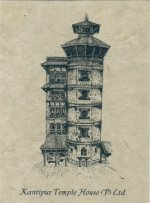 NEPAL AND INDIA
February 1999
NEPAL AND INDIA
February 1999 As a child I remember thinking Kathmandu sounded exotic and mysterious and believing that all Nepalese wore umpteen layers of clothing against the cold. Funny how when you meet the reality as an adult only part of the imagined is true!
We arrived in Kathmandu / Nepal to join a bird watching group for 8 days and then spend another week exploring its cultural heritage. Our hotel, though down a narrow rather unprepossessing lane, turned out to be delightfully clean and welcoming. The Nepalese staff were so polite and charming, 'Namaste' they'd say clasping hands together and bowing their heads every time we went past. On the first night a knock on the door heralded the delivery of a hot water bottle! That deserves at least one extra 'star!'
We soon met our fellow birders,
and over a typical Nepalese meal started to piece together backgrounds and
decide who might be the eager types and who the more leisurely types - like
ourselves. I had, on purpose, neglected to tell Brian that serious birders are
up by dawn as that's when birds are at their most active. Breakfast calls for
the next 8 days were at 5.30a.m. and the first morning we spent up Phulchowki
mountain. As the mist cleared we looked across green valleys and foothills to
some of the highest mountains in the world. Majestic and enduring, their peaks
glistened as the sun caught and reflected the layers of snow. Photography can
rarely convey or do justice to the raw power of these giants as well as one's
eyes. Birding is forgotten for a while as we just stand and look, completely
awed by the panorama - Anyway, hill birds, scratching in the undergrowth or
twittering from high tree-tops are not really the best starting point for
amateurs. We just enjoyed the spectacular views as we walked to the top to
have our packed lunch by a Buddhist shrine festooned with colourful prayer
flags.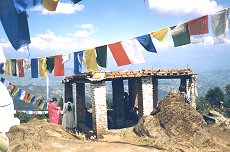
Our young Nepalese ornithologist, Hathan, was delightful, ensuring that we saw a variety of habitats and a large number of birds including some of the endangered species. While driving along the Koshi River we stopped a couple of times to see beautiful Ibisbill. This is a large grey and red bird with a long decurved bill and it blends so well with the rounded grey boulders that without expert help one would be unlikely to see it. Another highlight was to see a bare branched tree dripping with around 40 Griffon Vultures, indeed the skies were often full of circling birds of prey. Four miles away, with only an 'up-the-bum' view Hathan would confidently say "One Crested Serpent Eagle and two Lesser Spotted Eagle". To us they were circling blobs, but who were we to argue!
Before we went Brian had practiced
some of the 'finer' aspects of birding. He quickly adopted the correct stance
with binoculars and learnt a few of the names of parts of birds, like 'rump',
'primaries', 'vent', 'nape' etc.! 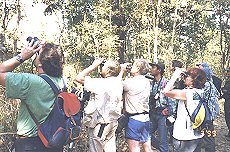
Despite that and throughout the trip the Red Vented Bulbul and Little Grebe remained the 'Sore Botty bird' and the 'Fluffy-Bottom-Pointy-Bill bird' and his most boring hour each day was while the group sat round after dinner going through the day's bird list disputing whether 3 or 'was it 4' of a particular species had been seen! He sank into a mild stupor that definitely had more to do with the list than the beer!
When we booked, the clothing instructions suggested gloves, balaklava, warm jackets, waterproof trousers etc. and we believed that the temperature might be in and around freezing - well, you would do, wouldn't you? But the weather in lowland Nepal was glorious - the thermometer reaching shorts and T-shirts each day! (or mid to high twenties!) I must mention three of the particular outings that were organised for us. Canoeing down the Koshi River in a narrow dug-out tree trunk, over boulders thinly covered by bubbling water. The river bed was wide and mainly peaceful, as we were there before the monsoon rains swell it to a raging torrent. Domestic cattle grazed on the grass, Red necked Ibis and Cormorant wandered the shallows and the sun shone. The second time we went further down the river in three 12-man inflatables and here it was so wide you could hardly see the other bank. Gharials and crocodiles live in the water and wild buffalo roam the National Park land on either side. It was a very sunny, hot day and two of the group went into the water to cool off, but the thought of crocs sharing the water prevented us from joining them! My favourite excursions though, were in Chitwan National Park. The elephant rides. We had been told that it was 90% certain we'd see wild rhino, but a very remote likelihood of seeing tiger and also that rhino and tiger are unlikely to charge an elephant but, if they do, they attack from the rear! Twelve steps up to the elephant-mounting platform, then four people squeezed themselves into the houdah, and sat astride the four corner posts.
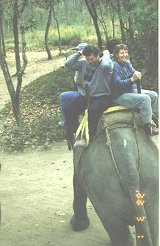
Brian and I got rear gunner positions! Off we set through the ancient forest, the elephant walking slowly and with great delicacy so he hardly made a sound. Early on we saw a number of birds and then wild pigs and their piglets, totally unperturbed by the presence of the elephant. Suddenly the mahout pointed to one side and a rhino with youngster was a mere 12 feet away! She was very wary and stayed between the calf and us. No one had to remind us not to talk, we were hardly breathing! After eyeing us for about 5 minutes with the tiniest little piggy eyes imaginable, she pushed her way off into the undergrowth. Pushing through undergrowth seems to be quite normal for these huge animals because the elephant did the same until we unexpectedly came upon a rhino wallowing in a pool and without a word of a lie we can tell you that rhinos fart! We saw the telltale bubbles!
I loved the ride on the elephant
and went for a second ride in the afternoon instead of a walk through the
forest. A total of 8 rhino and 2 sloth bear! We didn't see any tigers, just
tiger prints in the muddy path but on our return to Kathmandu the local paper
reported the death of 2 villagers, eaten by a tiger that very week! Just a few
bones were left.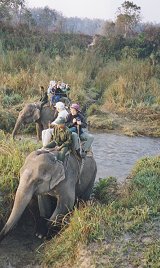
Of the twelve people in the group, we were the least accomplished at bird recognition, the serious slot being taken by a policeman and Nature Conservancy fellow who had pored for the past 3 months over a 4-inch thick 'Birds of India and Nepal' every evening in their local pub! One of the ways you can tell a committed and serious birder from an also-ran is that the committed ones find LBJ's exciting, whereas the rest of us like flashy colours and bigness! (not Little Brown Jobs!) The important thing was that we all got on well, laughed a great deal and will remember the trip with great pleasure. A final word about the birding bit, three of the group had palm sized Digital Video cameras. Revelation! Zoom, clarity, playback facility, seriously small size - we got very smitten!
Of the ten highest mountains in
the world, Nepal boasts eight and we had organised that after our bird
watching we would go to Pokhara, a mere half hour flight from Kathmandu, and
sit relaxing and reading in the foothills of the Annapurna Range. 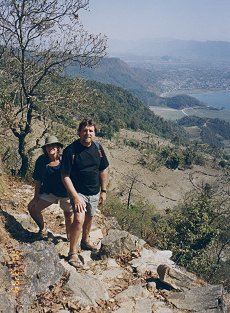 We did, but
the tour company had also organised a day hike, with picnic lunch, to the top
of Sarangkot Hill and dutifully we trudged upwards in the building heat of the
day. Stunning views of Machupuchre (Fishtail Mountain), Annapurna ll, lll and
lV with the wind whisking snow off the peaks and a few fluffy white clouds
clustering below. The worst part was a day later when the effects of climbing
steeply down 1000ft to the lake hit hitherto unworked muscles in calves,
ankles, shins and thighs! We got out of bed and our leg muscles went into
spasm, each step was agony and climbing up or down stairs, sheer hell! But
sitting on the lawn in warm sunshine with magnificent mountain views, drinking
the odd shandy and reading restored us to normal again.
We did, but
the tour company had also organised a day hike, with picnic lunch, to the top
of Sarangkot Hill and dutifully we trudged upwards in the building heat of the
day. Stunning views of Machupuchre (Fishtail Mountain), Annapurna ll, lll and
lV with the wind whisking snow off the peaks and a few fluffy white clouds
clustering below. The worst part was a day later when the effects of climbing
steeply down 1000ft to the lake hit hitherto unworked muscles in calves,
ankles, shins and thighs! We got out of bed and our leg muscles went into
spasm, each step was agony and climbing up or down stairs, sheer hell! But
sitting on the lawn in warm sunshine with magnificent mountain views, drinking
the odd shandy and reading restored us to normal again.
Kathmandu has been described as a
'toilet on top of a dung heap', it's medieval temples and houses built eave to
eave without any form of planning. There was squalor, dirt and overcrowding
but also tolerance, politeness and a mellow manner to others. The relaxed
attitude to 'spaced out' hippies draped over Temple steps has hardened in the
past few years, although 'Want some grass, man?' was whispered in our ears
more than once! The main Durbar Square was full of ancient Temple buildings,
'commercial' monks (sitting in semi-rags, grey ash on their bodies waiting for
the unsuspecting to take a photograph, whereupon they demand baksheesh!),
sacred cows, scabby dogs, stinking goats and more feral pigeons than in
Trafalgar Square. 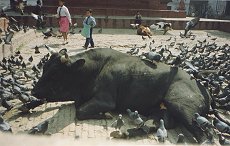
Add to that the narrow streets unable to cope with more than a bullock cart or two and the amount of road taken by those setting up vegetable, lentil, spice or tourist stalls and maybe you start to get an idea of the colour, noise and sheer life of the place! Ceremonies and age-old religious rituals abound, we saw the "Living Goddess" at her Palace window for a brief moment. Poor girl! Chosen from obscurity at the age of 4, she must live in her palace without setting her feet on the ground, (except to be carried by palanquin around the city on festival days) be worshipped and adored by the faithful and then be summarily returned to anonymity as soon as she reaches puberty. Left with a State pension she doesn't need to work, but no-one will marry her as men believe that co-habiting with a goddess will result in their death. The young face at the open window was heavily made up and bored, a symbol for the religious and a 'freak' for the tourists.
As we wandered through the various
Durbar Squares unique architectural styles, age and history was in every
glance; Kathmandu bustling, congested and full of tourists; Patan ceremonial,
quieter and Bhaktapur the most refined, gilded and spacious of them all. So
many temples are still actively used and religious tolerance allows them all a
place. Buddhist shrines with their fluttering, brightly coloured prayer flags
and spinning prayer wheels. Hindu shrines to a whole variety of Gods with
their smearings of ghee, flickering oil lamps, flower offerings and temple
bells. Since 1950 Tibetan refugees have also been absorbed into the
multi-cultural nature of the country, but the emergence of a Muslim thread in
recent years has caused the first signs of religious
intolerance.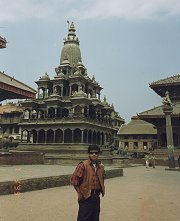
We were astounded to hear from our young, trendy (sad about his fake leather jacket!) guide that about 75% of the population are 'economically inactive'! Everywhere we saw individuals working the fields with fairly primitive tools, village houses built of bamboo and mud, row upon row of 'buffalo dung kebabs' drying in the sun, children dressed in simple dresses or shorts and a way of life based on hard manual labour. Nepal has little in the way of natural resources but what it does have is a bunch of the highest mountains in the world, a fertile terai (lowland) and wonderfully good-natured people. It is keen to attract tourists as they bring in much needed foreign currency, and so the trekking 'cult' is cultivated! Small 'Trek and Tour' companies are dotted all around the main cities of Nepal, and people of all shapes, sizes and nationalities are there for easy, short, lowland, upland, foothill, montane and snowy treks. Every street has shops and stalls ready To furnish the trekkers with specialist equipment like new and secondhand boots, hats, thermals, jackets, sleeping bags, tents and waterproofs. Just as in India, the price for buying is negotiable and so I started to hone my bargaining skills in some small souvenir shops. Embroidered T-shirts for £2.00, a carved Yak bone bracelet for £1.00, a Tibetan silver dish (expensive at £6.00!) and a few other bits and pieces. Brian and I differ in our approach to the whole bargaining business, he's often content to give the asking price - working on the "Is it worth that to me?" principle; whereas I work on the "50% principle". I don't buy unless I've bargained nearly 50% off!
We flew north west to Delhi and were met by the Tour Company that were responsible for our 'cultural' trip in India. The hotel we were placed in was really central but looked like 2 wings of The Maze prison! (Back to that later!) We walked to Connaught Circus and found an Optician, had eye tests, chose frames and coatings then waited only four hours for them to be completed! Brian chose 'Varilux' lenses which are really excellent and I had a pair of 'light as a feather' distance glasses. Total bill £200 - much cheaper than UK or Cyprus!
Back to the Hotel where the TV
sound was so distorted we couldn't hear BBC World, water in the shower was no
more than a lukewarm, feeble dribble and the 'maintenance men' just stood by
the dribbling tap unable to see the problem, "Water come, Sir! Look, see
water!" "Yes, but the problem is that it isn't hot and there's not enough
water pressure to have a shower!"
"You wait, Sir, water come - maybe 10
minutes?"
We could
have waited all night; instead, we threatened going elsewhere. That brought
consternation and offers of 'other rooms'. We traipsed round four hotel rooms
testing water temperature and pressure, finding similar problems but the same
questionable promise that "Tomorrow it will be good, Sir".
We abandoned any idea of a
shower! The next day we discovered that Hotel Janpath is a Government-run
establishment. It answered why all the workers were well fed, lethargic and
satisfied with poor performance and why the Hotel was so inefficiently run.
Jobs for life with secure pensions and no fear of comparison or competition!
We demanded the Tour Organiser cancel our last night in The
Janpath!
The design of New Delhi in the 1920's by the British and their chief architect Sir Edward Lutyens, is a testament to self-assured arrogance, ideas of Empire and grandeur and the certainty that Right was on their side. It is wonderful to behold. Majestic wide avenues, long vistas with imposing memorials at the centre and vast red sandstone buildings with pillared porticos and flambouyant cupolas. (At least it wasn't so brazen as the equally grand, manicured Government building in Bangalore that boasts "Government Work is God's Work" over its entrance.) Other places we visited were the Red Fort with its serious battlements on the outside and its elegant palaces on the inside; the vast Friday Mosque with enough space for 4,000 genuflecting Muslims and the Q'tab Minar, a richly carved tower or 'adult' minaret.
Our next bit of cultural
experience was at Sananger, a town renowned for block printing of calico. 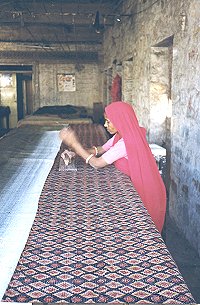
The River banks were draped with huge washing lines of coloured cloth drying in the sun and the streets were full of camel drawn carts piled high with folded bolts of patterned material. The technique for printing has not changed for hundreds of years and requires skilled co-ordination of hand and eye. We went into a factory (that would never pass any EU regulations for Health and Safety!) to watch material being printed - a slow and labour intensive job. I bought a tablecloth with 6 napkins and five King Size throws for £35. (For the cats, you understand - and to protect the newly upholstered settees and chairs!)
Then on to Jaipur, the Pink City. We had asked to stay in the Samode Haveli, a haven of peace and prettiness inside the bustling and lively city. Wealthy merchants built themselves houses with large central courtyards, ornate facades, carved doors and window frames and no surface undecorated! Glorious riots of intertwining flowers and geometric patterns adorned every surface in the painted dining room and our bedroom was a mixture of antique elegance and space.
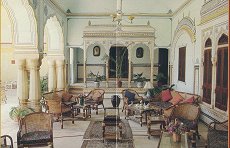
Long before the city of Jaipur was built by Jai Singh, the area was governed from Amber, an area naturally fortified by hills and high ramparts. Now the old Fort and Palace there are filled with tourists and tourist trappings, the worst (according to Brian) being the troupe of 40 elephants that slowly waddle up to the Palace courtyard. (I disagreed and loved riding on the elephant even though it was tacky tourist stuff!) The Fort and Palace is slowly decaying through lack of adequate funding and investment, and despite its wonderful location will become a sad reflection of its past greatness.
Bharatpur - one of the world's most important bird sanctuaries was next on the list. Originally a freshwater swamp which the local Maharajah had dug out to form a lake and then from 1902 he entertained the British there with splendid duck shoots! Back into ornithologist mode and we were up at 5.30 to enjoy a morning of stunning birdwatching. With a bicycle each we rode through the sanctuary and saw Painted Stork, Glossy Ibis, Bronze-winged Jacanas, Snake birds, Spoonbill, Pelican, Herons and Egrets in their hundreds, Bar-headed Geese, Kingfisher, Spotbill Duck, Shoveller, Cotton Teal, Black-winged Stilt and Snipe. Treepie, Bulbul (Red-vented, White whiskered and White cheeked), Coucal; Brahminy, Pied and Indian Mynas as well as Jungle Babblers, shrieking Rose-ringed parakeets and Little Green Bee-eaters! Each time you put the binoculars up to your eyes the sight was full of interesting birds! A wonderful experience.
Gwalior was next on the agenda. 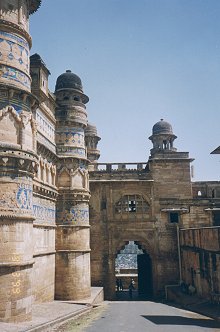
The earliest Fort that we had seen - by some 150 years. Completed in 1512 the Fort walls were covered in rows of bright coloured tiles. Rows of yellow ducks, (looking exactly like little yellow plastic bath ducks!) crocodiles, elephants and banana leaves making a quite extraordinary impression. But the rest of the Fort area was so sadly neglected, graffiti on the crumbling walls, piles of leaves and twigs heaped in every corner, dirty and dusty, full of pigeons, bats and domestic animals. As we wandered through room after room the typical Indian urinal smell got to our noses. It's a sad place almost without visitors and yet up on the hill the wind was cool, the view panoramic and the peacefulness almost tangible.
Our penultimate day was dedicated to Agra and "Heart of Indian Tourism" as our Indian Guide called Emperor Shah Jehans' Taj Mahal. Over the past twenty years the glistening white marble of the Taj has dulled due to the pall of pollution that hangs over the city, so diesel and petrol vehicles are not allowed within 1 km. of the Taj and the final approach is made in an electric coach. How unprepossessing the ticket entrance where guards with black bandanas and old Lee Enfield guns watched as we were searched and my last 3 toffees were rooted out of my rucksack and confiscated. Finally we gained entrance and nothing prepares you for the beauty and size of the monument. The Main red sandstone gateway is a large, ornate and beautiful building itself, but standing there, looking down the narrow water channel towards the creamy white Taj the effect was beautiful. A perfectly sunny sky, clean green grass, dark conifer trees and colourful flower beds all an exquisite foil for the marble mauseleum. As a piece of real estate it has all three important assets; position, position, position! But added to that it has breathtaking craftsmanship, elegance and intense passion. One of the 'must sees' of the world!
Agra Fort, another place that
blows romanticism into overdrive. Gloriously positioned on a curve of the
Jamuna river and beautifully crafted by the same artisans that shaped the Taj,
it held the imprisoned Shah Jehan for the years prior to his death. Imagine,
every day for 16 years, weeping as you look down the river at the mausoleum
you built in memory of your beloved wife - and not being able to go to
it.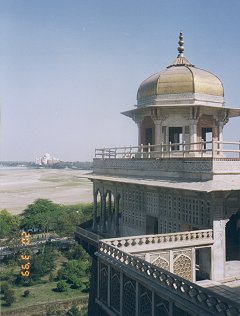
Agra is a city where you can indulge romanticism! So, having done just that, we were driven back to Delhi and the end of another excellent holiday.
[Our tours were all booked through the Internet and as we used local firms we felt we got very good value for money. If anyone is contemplating any similar trips - we would be glad to give more details of companies, tours, hotels and guides. ] Absolutely everything (for the two of us for 24 days) cost £2,500.
Return to Contents